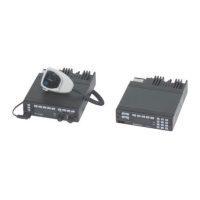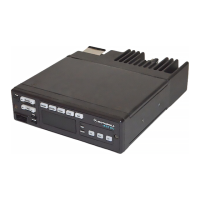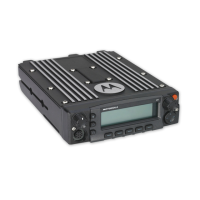Theory of Operation: Tone Remote Control Board
28 6881086C22-B
pin 41). The input to this pin is a 0-5V peak-to-peak square wave. The
frequency of the square wave depends on the particular guard/function tone
being sent. The microprocessor determines which tone is being sent and then
takes the corresponding actions.
AGC Circuit Operation The output of U112 op amp 4 feeds reference comparators (U117 op amps 2,
3, and 4) of the AGC circuit. If the peak voltage at the input exceeds the
threshold of U117 op amp 4 (+5.8V) in the positive direction, the output of U117
op amp 4 pulses high, causing current to pass through R510 and charge C506
via D1012. Similarly, if the peak minimum voltage at the input dips below the
threshold of U117 op amp 3 (+3.6V), U117 op amp 3 will allow a pulse of
current to pass through R509 to charge C506 via D1013. As C506 charges, the
DC voltage on the gate of Q113 rises. This rise in gate voltage on Q113 will
reduce the drain-source resistance and hence the gain of U112 op amp 1. This
in turn will reduce the output of the AGC circuit. This output is again used to
feed the comparators, and the process continues until the voltage is just equal
to the threshold of U117 op amp 4 minus the threshold of U117 op amp 3, or
2.2V peak-to-peak.
The “sample-and-hold” action of the AGC occurs when a new HLGT is
received. Upon detection of HLGT by the microprocessor (U123 pin 41), the
AGC_RESET* line (which has been low when no LPTT was present) and the
TONE detect line will go high (approximately 5V). This action will cause the
gain of Q113 to rapidly increase (C503 is placed parallel with the smaller C506,
reducing the gate voltage on Q113), and also turns Q110 off to allow a higher
gain in the U112 op amp 1 stage. This action will momentarily cause a rise in
the AC voltage level on TP1 above the usual compression point of 0 dBm.
During the time that the peak voltage on TP1 is more than 0.7V higher than the
1.1V peak (0 dBm) threshold, comparator U112 op amp 2 and Q116 are
actuated to provide faster than normal attack (gain reduction) time. In this
manner, the gain is always reset to maximum at the beginning of a new line
push-to-talk, and then is reduced as required until the HLGT is at 0 dBm (which
is the AGC compression point) as measured on TP1. This ensures full
deviation, regardless of the amplitude of any audio signal on the line just prior
to the line push-to-talk.
During an LPTT function, the Auto Level Control (ALC) action of the AGC
causes the gain to freeze for the duration of LLGT. This will preserve the natural
characteristics of the speech without producing any pumping effects.
In extreme cases where the audio signal received at the Consolette is
unusually low (due to very long lines or other attenuating factors), the AGC
action of the TRC board may be inhibited, yielding slightly more gain. Switch
S100-4, when set to the ON position, will disable the AGC circuitry. Absolute
gain and transmit deviation is then adjustable by potentiometers R529 and
R569, respectively. This option is NOT recommended because the Low-Level
Guard Tone (LLGT) may already be too low to be detected and thus the
Consolette will not transmit.
Power Distribution A+ is routed to the TRC board from the power supply through J11. This
connection provides ignition sense to the control head and the mobile. When
S101-1 is in the ON position, A+ is immediately sourced from the power supply
to the SWB+ connections of the mobile, control head, and TRC board. When
S101-1 is in the OFF position, the user must enable power at the front of the
control head. SWB+ is then sourced from the control head to the mobile and to
the TRC board.

